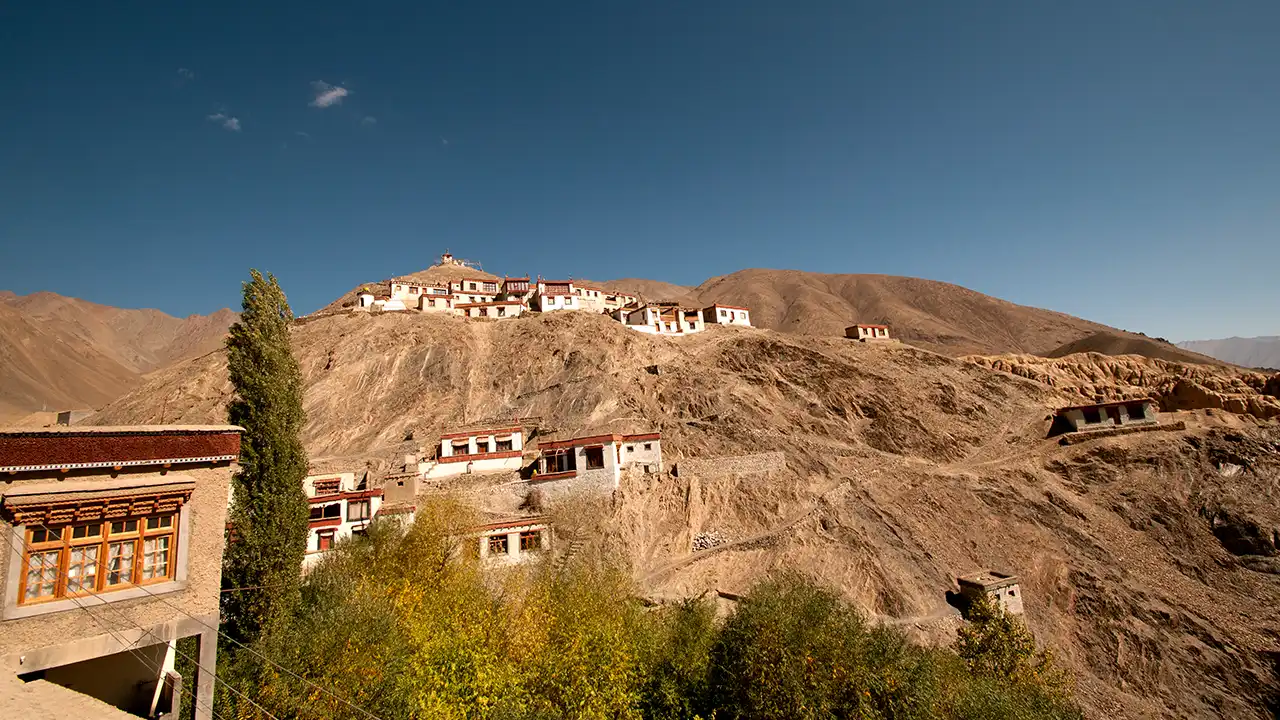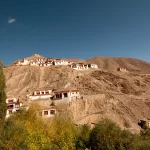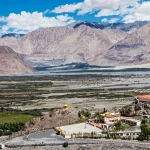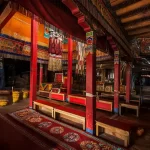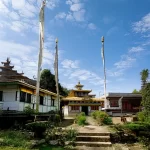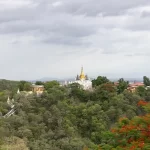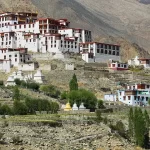Dramatically perched on a steep mountainside overlooking the Srinagar-Leh Road, Lamayuru Monastery is Ladakh’s oldest and most stunning Buddhist monastery. Backlit against surreal, moon-like landscapes, the monastery is a timelessness symbol of piety, resilience, and Himalayan mystique. Tradition has it that Naropa, a renowned Indian Buddhist scholar and driving force behind the emergence of the Kagyu school of Tibetan Buddhism, established it. The belief is that the place was initially a lake, and Naropa made the water withdraw by casting a spell, thus paving the way for the establishment of the monastery on the new land.
The monastery was initially a Bon site, devoted to the pre-Buddhist Tibetan religion. It was subsequently transformed into a Buddhist monastery, and it is one of the oldest continuously operating monastic institutions in Ladakh. The Bon origins are still evident in some rituals and architectural features retained at the site.
Lamayuru ultimately fell under the banner of the Drikung Kagyu school of Tibetan Buddhism. It served a key role in disseminating Buddhism in the western Himalayas and had a monastery once home to 400 monks, although this figure has diminished to about 50 now.
Architecture and Layout
Lamayuru Monastery stands on a rocky hill at an elevation of around 3,510 meters (11,520 feet) above the valley with eroded cliffs and undulating rock formations that look like the surface of the moon.
The complex includes:
Main prayer hall (Dukhang): Fitted with beautiful frescoes, thangkas (scroll paintings), and elaborate woodwork. It also contains statues of Buddha Shakyamuni, Avalokiteshvara, and other deities.
- Stupas (Chortens) and manuscript halls filled with holy texts and ancient artifacts.
- Cave shrines are said to have been Naropa’s meditation places.
- Monks’ residences and cells, dispersed across several levels of the rock face.
The buildings are simple but well integrated into the landscape, giving a feeling of spiritual immersion. Its earthy colours and whitewashed stupas provide a striking contrast to the harsh browns and yellows of the surrounding mountains.
The Ladakh Moonland
The landscape surrounding Lamayuru is sometimes called “Moonland” due to its alien landscape. Conditioned by centuries of wind erosion, the smooth, rounded hills and deep gorges produce an ethereal landscape, especially during the full moon.
Not only does this natural feature add beauty to the visuals of the monastery but also spiritual atmosphere. According to belief, the land harbors sacred energy, and meditation is claimed to be highly beneficial here.
Murals, Art, and Spiritual Symbolism
Murals and paintings are renowned at Lamayuru Monastery, most of them being centuries old. These paintings depict:
- Incidents from the life of the Buddha
- Various Bodhisattvas and tantric gods
- Symbolic representations of the wheel of life (Bhavachakra) and meditation mandalas
The murals demonstrate a blend of Indian, Central Asian, and Tibetan art forms, bearing witness to the cultural interactions of the monastery. Their vivid colours, which have stood the test of time in Ladakh’s dry climate, continue to inspire visitors and scholars alike.
Monastic Life and Ritual Practice
Despite having fewer resident monks today, Lamayuru remains an active monastic center. The monks of the monastery spend their day on:
- Prayer and meditation ceremonies held in the large prayer halls
- Scriptural study, including transmission of the Kagyu school
- Community rituals, especially those celebrated during festival seasons
- Monks can be viewed chanting ancient scriptures, turning the prayer wheels, or performing traditional ceremonies—every action permeated with centuries of significance.
The monastery is also a religious retreat for spiritual seekers and travelers looking for silence and contemplation in a holy setting.
Yuru Kabgyat Festival
One of the main festivals at Lamayuru is the Yuru Kabgyat Festival, celebrated every June and July. This vibrant festival is succeeded by:
- Cham Dance, or masked monk dances, symbolizing the triumph of good over evil
- Rituals for warding off evil spirits and blessings over the area with peace and prosperity
- Recitation of holy writing, mandala offerings, and ritualistic stripping off of masks
- Tourists and locals visit the festival, giving an insight into Ladakh’s rich cultural and spiritual heritage.
Travel to Lamayuru
Lamayuru is about 125 kilometers from Leh on the Leh-Srinagar highway. The drive to the monastery is an experience in itself, traversing mountain passes that are towering, green oases, and lunar-like desert landscapes.
Travel Information:
Best time to visit: May to September (road open; summer weather)
Opening hours: Usually from 8:00 AM to 6:00 PM
Entry fee: Small fee for maintenance and conservation
Basic homestays and guesthouses exist in Lamayuru village, where travelers can stay overnight and view sunrise and sunset over the Moonland—a heavenly experience.
Preservation and Contemporary Challenges
Being one of the oldest monasteries in Ladakh, Lamayuru has preservation challenges:
- Weather erosion poses threats to structural integrity
- Tourism, although economically positive, exerts pressure on the delicate infrastructure and artworks
- Climate change is altering the region’s ecosystem, impacting the water supply and increasing the frequency of landslides
To combat this, efforts are being made by local monks, NGOs, and heritage conservationists to document, restore, and preserve the monastery’s art and architecture for future generations.
Legacy and Spiritual Significance
Lamayuru Monastery is not just a monument, but a living spiritual heritage. For centuries, it has been a refuge for monks, pilgrims, and seekers of the truth. Its holy caves, ancient frescoes, and tranquil prayer halls have provided a source of limitless hours of meditation, contemplation, and enlightenment.
Its located peace, its heritage beauty, and its prayer hall silence revive every traveller who comes to halt, stillness, and renewal.
No matter the reason one arrives – the breathtaking view, the sacred atmosphere, or the heritage – Lamayuru offers something eternally peace.

